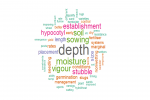Key points
- The Ripper Gauge project revealed significant variability in crop response to soil amelioration across different soil types
- Deep ripping showed consistent benefits on deep sands but less clear advantages on other soil types. ROI ranged from a $620/ha benefit to a $656/ha loss
- Soil testing and analysis are crucial before implementing any soil amelioration strategy
A Western Australian study urges caution in soil amelioration practices, highlighting the need for soil-specific strategies to optimise crop yields and economic returns
A cautious, data-driven approach to soil amelioration is being advised following the results of a comprehensive study in Western Australia. The Ripper Gauge project, which ran from 2018 to 2022, found deep ripping and other soil amelioration practices can significantly boost crop yields on some soil types. However, it can also lead to economic losses for others.

The project’s final report highlights the significant variation in crop response to amelioration between sites, crop types, years and seasonal conditions in a controlled-traffic farming system.
Return on investment (ROI) varied across different soil types: from a $620 per hectare benefit over three years at a Yuna site to a $656/ha loss at a Darkan site. The Yuna site was ripped to 60 centimetres with inclusion plates. At the Darkan site a mouldboard plough was used.
The report says that deep ripping demonstrated consistent benefits on deep sands, but the benefits were less clear for other soil types. There was also a trend of diminishing benefit for each soil amelioration treatment from 2018 to 2020. This variability in response made it difficult to provide universal recommendations for all soil types and underscored the necessity of thorough soil analysis before embarking on costly amelioration programs.
The project
The Ripper Gauge project was led by West Midlands Group chief executive officer Dr Nathan Craig and involved nine grower groups and a network of 20 demonstration sites across five port zones.
Soil types tested ranged from sands to loamy soils, gravel and sand duplexes, forest gravels and clay-based soils. The project investigated ripping with a straight or angled shank ripper to 30cm and 60cm. It involved the use of equipment such as:
- a rotary spader
- a mouldboard plough
- a Plozza plough
- a one-way plough
- an offset disc plough
- a scarifier
- a straight shank tyne with plates
- aggressive tillage.
Economic analysis
Economic analysis showed that 60 per cent of treatments returned a positive benefit. The average cumulative net return over three years was $164/ha. The average cumulative loss from the other 40 per cent of treatments was $154/ha.
As well as assessing soil amelioration by soil type, the project evaluated early post-emergent deep ripping at one, three and six weeks after sowing at four sites in 2021-22. This was an alternative to traditional pre-seeding deep ripping.
It found ripping after sowing impaired plant establishment and vigour, allowing more weeds to germinate and likely reducing grain yield.
“However, pre-seeding ripping consistently improved plant establishment, early vigour
and grain yield compared to the control,” the report says.
“Therefore, growers should prioritise pre- seeding ripping over post-emergent and non-ripping methods to achieve better agronomic outcomes.”
Soil testing importance
GRDC grower relations manager – west – Berin Gibbons says WA growers have used deep ripping for decades to break up compacted layers on sand plains.
After growers in the Geraldton Port Zone found they were getting significant improvements from the practice on deep sandy soils, many began repeating it every few years.
“But when you start moving to soil types with more clay content or other issues, it doesn’t always yield a positive result and, as has been found in this investment, you can get a negative return,” he says.
Mr Gibbons says the study corroborated some growers’ experiences, and it shows the importance of soil testing.
“That’s the key takeaway message for me. Classify the types of soil you have within a paddock and test to depth to determine what constraints exist.”
Mr Gibbons says classifying soil throughout a paddock, especially where there are variable soils, and testing to depth would help identify constraints to be addressed. That could be water repellence, compaction layers, acidity, toxicities (for example, aluminium or boron) or sodicity. This will guide decisions on the best form of amelioration.
Nine steps to success
The nine recommendations from the project are as follows.
- Understand soil constraints: Conduct detailed soil analysis to identify specific issues such as compaction, acidity, salinity or water repellence. Tailor amelioration practices to effectively address these constraints.
- Research and be open to new machines: Stay informed about the latest advancements in soil management technologies. Experiment with new machines that offer different modes of soil loosening and mixing to find the most suitable equipment for your soil conditions.
- Conduct trials on your soil type: Before fully committing to any soil amelioration practice, conduct small-scale trials to test different methods and assess their impact on soil health and crop yield. Use empirical data to make informed decisions.
- Thoroughly assess options: Evaluate the long-term impact of different amelioration techniques on soil health and crop yield. Consider the cost of implementation, expected benefits and sustainability of the practice. Collect and analyse data to measure the actual benefits.
- Progressive adoption and investment: Adopt soil amelioration practices progressively across your farm. Start with small areas and expand as you gain confidence in the effectiveness and economic viability of the chosen techniques. Invest gradually based on solid evidence of economic return.
- Continuous monitoring and adaptation: Regularly assess the impact of your amelioration practices on soil health and crop yield. Make necessary adjustments based on ongoing observations and data collection. Secondary considerations include paddock trafficability, crop selection, weeds and herbicide packages.
- Collaboration and knowledge sharing: Engage with other growers, researchers and agricultural experts to stay up to date on the latest developments in soil amelioration practices. Take part in field days, workshops and industry conferences to share your own findings and learn from others.
- Environmental considerations: Ensure amelioration techniques do not have negative environmental consequences such as soil erosion, loss of biodiversity or contamination of water sources. Adopt practices that promote sustainable land management.
- Economic analysis and planning: Conduct a detailed economic analysis of different amelioration techniques. Develop a comprehensive plan that outlines the steps for implementation, necessary resources and a timeline for achieving results. Regularly review and update this plan based on ongoing observations and data collection.
More information: Berin Gibbons, berin.gibbons@grdc.com.au
Resources:
- GRDC Update Paper – How WA growers are practicing soil amelioration
- GRDC Publication – Tackling amelioration on variable soil types
- GroundCover™ story – ‘Moonshot’ investment tracks soil amelioration over time and space

























































